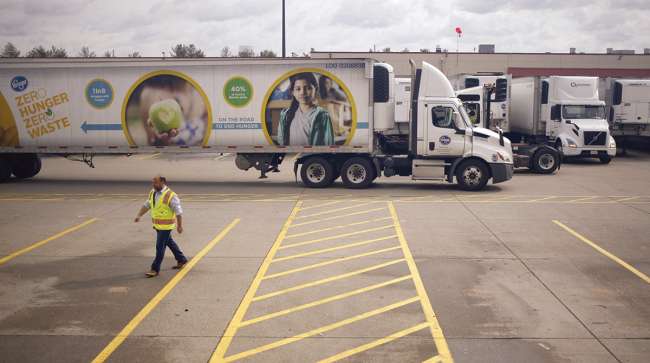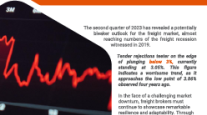Senior Reporter
Economy Is Improving, but Challenges Remain, Economists Say

[Stay on top of transportation news: Get TTNews in your inbox.]
The U.S. economy is poised for a strong recovery in the third quarter, provided the number of people being given the COVID-19 vaccine significantly improves and Congress and the White House reach a COVID relief package.
For trucking, capacity is likely to remain tight in 2021, with many companies having more work than they can handle, especially as the driver shortage worsens.
American Trucking Associations Chief Economist Bob Costello made those projections in a Transport Topics “Newsmakers” interview.

Costello
“The economy is doing better, no doubt about it. It doesn’t mean that everybody is doing better,” he said. “We had some stimulus late last year, and it’s pretty likely we’ll have some form of stimulus. We don’t know how big the package is; the president proposed $1.9 trillion. Is it closer to a trillion? Is it somewhere in between there? I don’t know, but all of that will help.”
Costello cited really strong growth in the 2020 third quarter, and said that he expects the fourth quarter will probably be around 3% growth — better than the historical averages. And for the first quarter, he sees growth of 2.5%.
“Then I think things will pick up once the stimulus hits the economy,” Costello said. “Overall, we’re not in bad shape.”
Costello and other economists believe in 2021 the U.S. economy will be on more of an even keel than the roller-coaster ride that they saw in 2020, especially when the Gross Domestic Product plunged by 31.4% in the second quarter only to come back with 33% growth in the third quarter and then finish the year with 4% growth in the fourth quarter.
Regarding trucking, the economy appears to have stabilized, according to DAT Freight and Analytics, which publishes a weekly report on freight loads and rates.
The national average spot truckload van and refrigerated rates were virtually unchanged during the first week of February, a sign of price stability after January’s declines, DAT reported Feb. 10.
Rates for vans were $2.29 a mile, flatbeds were $2.47 a mile, and refrigerated trucks $2.55 a mile. The month-over-month stability in prices came as the number of dry van load posts increased 7%. The number of spot reefer load posts increased by 13%, and flatbed load and equipment posts increased 2% last week.
Spot market rates have also found support at their current level, as prices hold steady while shippers restock warehouses with spring inventories ahead of Chinese New Year. https://t.co/CuHk6mldNg — DAT Freight & Analytics (@LoadBoards) February 8, 2021
“The fact that spot rates are so high and contract rates are up around the same level, carriers are doing pretty well compared to this time last year,” DAT Freight and Analytics analyst Dean Croke told TT. “Carriers are doing much better this year than they were at this time last year.”
Croke said trucking companies that transport agriculture products will likely see an increase in business as spring planting begins and in Florida, where it’s now the peak season for winter strawberries. In 2020, growers moved 76% of their total yearly volume between Jan. 25 and March 28, according to the U.S. Department of Agriculture.
Another challenge for the trucking economy concerns the situation at the nation’s ports, where several facilities, including Los Angeles, Long Beach, New York and Oakland are facing long backlogs to unload ships and transport of goods by truck.

LaBar
On Feb. 10, at least 27 ships were anchored offshore in Southern California, awaiting slots to unload. Farther north at the Port of Oakland, the global ship tracking company MarineTraffic said 17 ships were anchored on Feb. 10.
Harbor Trucking Association President Weston LaBar said West Coast ports have seen ship anchor numbers fluctuate from the mid-40s to the high 20s. “It’s the status quo. It hasn’t gotten better, and it can’t get much worse, and it’s likely to be that way for several more months.”
LaBar also expressed concern about a labor shortage at the ports.
“You’re seeing an erosion of your existing workforce because of the impact of COVID,” he said, “because of infections, or folks that feel they’re at high risk and don’t feel comfortable coming to work.”
Costello said despite the increased demand for consumer products, the driver shortage continues to cause challenges for fleets.
In addition, the Federal Motor Carrier Safety Administration recorded more than 56,000 drug and alcohol violations last year. About 45,000 of them are estimated to be suspended from driving, and the majority of that group, some 34,000, have not yet completed the return-to-work program.
“I think the biggest challenge our economy faces going forward is something we are very familiar with within the trucking industry, and that is having enough high-quality labor. It’s really tough out there,” Costello said. “We’re eventually going to go back to our traditional GDP growth rates, and that’s closer to 2% plus — not 3% plus, like I’m expecting this year. But we simply don’t have enough people to sustain higher GDP numbers.”
Want more news? Listen to today's daily briefing below or go here for more info:




